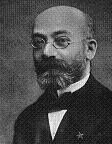What is Esperanto?
What is Esperanto? Esperanto is a constructed language, invented in the late
1800's. It is referred to as an 'international auxiliary language,' intended to
facilitate communication between people of different native languages. Simply
put - it's a a second language for everyone.

Esperanto's creator, a Polish oculist named L. L. Zamenhof, knew first hand the problems caused by the lack of communication between people of different native languages. Early in his life he saw conflict, misunderstanding and war in Europe that he felt could be lessened or overcome if communication were easier between the diverse people of Europe and the world as a whole. To this end, he constructed Esperanto, intending it as a means of easy communication, a second language everyone could learn quickly, use easily, and carried no political baggage.
Although Zamenhof was not the first to propose this idea, Esperanto is the
only constructed language that has had any success. Well over a hundred years
later, it continues to be used today and appears to be growing. Esperanto enjoys
a significant presence on the internet, with many pages, sites, organizations
and radio programs from around the world.
Why has Esperanto been successful where other, better constructed languages have not?
It is difficult to say what is so successful about Esperanto. It has its
critics. Some say it is too European to be a true 'international
auxiliary language.' Others say it is not European enough, or that it is
not natural enough. Some say it could be simplified even more, that if Zamenhof
had been a linguist or grammarian (he was an accomplished polyglot but didn't
have a linguistics background) he would have avoided a few problem areas. These
critics all have valid points, but I think the true test for a constructed
language lies in it's acceptance by non-grammarians.
Zamenhof had a vision and a passion which is still felt by Esperantists. He created a living, breathing language that has grown and changed since it's invention. The linguists may have constructed better languages, including some improved versions of Esperanto, but none of these have ever been accepted by a world-wide community of speakers the way Esperanto has.
You can find translations of Tolkiens 'The Lord of the Rings', H.P.
Lovecraft, Edgar Allen Poe or Franz Kafka in Esperanto, but you won't find them
in any other constructed languages. You can find original works in prose and
poetry, weekly radio programs, a horror movie (starring a pre-Star Trek William
Shatner), and numerous bands and musicians from around the world recording music
in Esperanto.
What is Esperanto like? Is it hard to learn Esperanto?
Esperanto is largely based on Latin, but also borrows from modern
European languages like French, English and Polish. Zamenhof chose word roots
that would be recognizable to the greatest number of people. In this way, anyone
who speaks a European language already has a large amount of vocabulary in
Esperanto. The pronunciation is easy, similar to Italian with some influence
from Eastern European languages.
Because of the 'internationality' of the vocabulary, and the relative simplicity of the grammar, Esperanto is very easy to learn. Estimates range from 4 times easier to learn than national languages, to as much as 10 times easier to learn Esperanto!
Zamenhof knew that Esperanto needed to be simple. So he devised Esperanto to have only 16 basic rules of grammar or syntax with no exceptions, unlike French or English or other national languages which seem to have endless exceptions. He also knew that it needed to be easy to read and write. He created a simple orthography with a basic rule of 1-sound 1-symbol. An 'e' will always be pronounced the same way, a 'c' is always pronounced the same way etc., and every letter is pronounced - no silent letters.
This is a far cry from English. Look at the following words:
through
thorough
thought
tough
The 'ou' combination is pronounced four different ways and the 'gh' combination is either silent or makes an 'f' sound. That's the orthographic nightmare of modern English. French isn't much better. This doesn't happen in Esperanto.
Zamenhof also chose sounds that were common to the most languages. At most you'll find one or two sounds that you aren't familiar with in your native language, and these will probably be easy to learn. The stress is always on the second to last syllable. All this makes Esperanto easy to pronounce. You can read and pronounce correctly even words you've never seen or heard before, once you learn the alphabet, which takes only a few minutes.
Back to Learn Esperanto
Language Learning Advisor Home
"A common creation demands a common sacrifice, and perhaps not the least
potent argument in favour of a constructed international language is the fact
that it is equally foreign, or apparently so, to the traditions of all
nationalities."
- Edward Sapir



